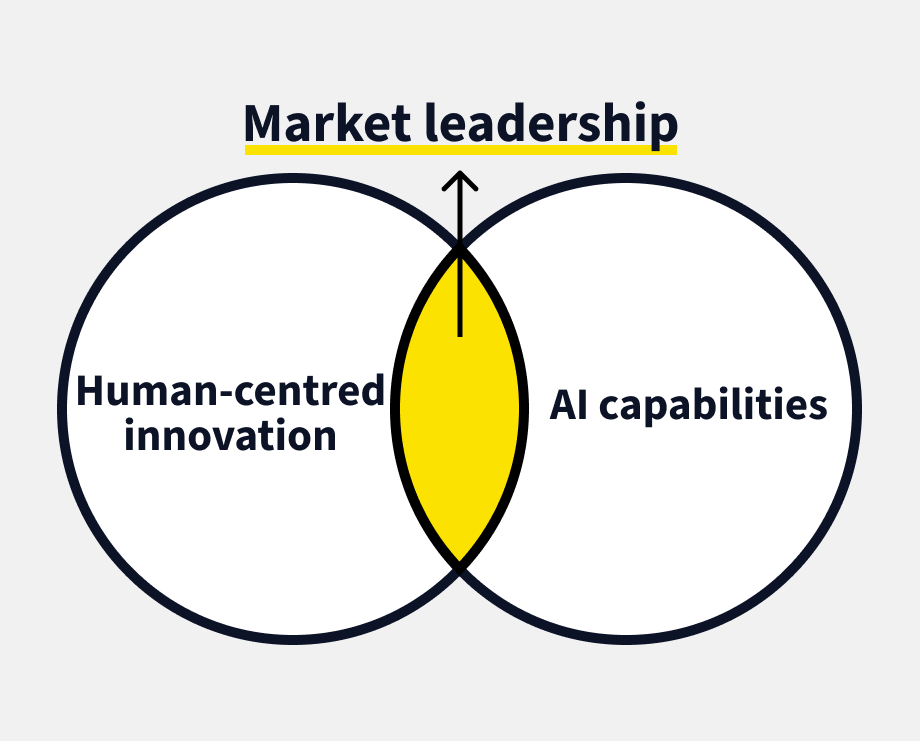Why customer-first matters more now than ever
Digital product creation is booming. Thanks to AI tools, low-code platforms, and open-source everything, almost anyone can get a product out into the world. The cost of entry is shrinking, and the competition is multiplying.
Technical excellence and deep subject expertise (whether you’re coming from education, healthcare, finance, or any other sector) are no longer enough to guarantee success. I’ve worked with enough product-led organisations to know that the ones who stand out are the ones who deeply understand their customers and shape their business strategy around that understanding.
In practice, that means:
Understand their customers and users in depth.
Shape their strategy around those insights.
Deliver products and experiences that solve meaningful problems.
When you start with the customer, you stop chasing your competitors and instead carve out your own space in the market.
The three pillars of a customer-first digital product organisation
From my experience, building a truly customer-first organisation is about embedding the right thinking into three interconnected areas: research, operations, and leadership.
1. Research-led insights
Sustainable product success comes from continuous and unbiased customer research, ie, systematically gathering the right evidence to answer the right questions.
In practice, this means:
Mixed research methods – Pairing qualitative techniques (one-to-one interviews, contextual inquiry) with quantitative data (analytics, surveys) to see both the “why” and the “what”.
Strategic focus – Designing your research to answer strategic questions that your leadership team needs resolved, avoiding scattergun data collection.
Representative user recruitment – Making sure the people you speak to actually reflect your customer and user segments, rather than just those easiest to find.
Rigorous analysis – Using frameworks like Jobs To Be Done or thematic analysis to translate raw insight into clear, actionable recommendations.
This depth of understanding allows you to move beyond surface feature requests and address the real drivers of customer adoption and loyalty.
2. Operational embedding
Customer-first organisations align every function, from product to sales and finance, around customer experience and outcomes.
One of the most common mistakes I see is organisations doing research but then leaving it to gather dust in a shared drive somewhere. Insights only have value if they’re used.
Here’s what operational embedding looks like in the best customer-first teams I’ve worked with:
Cross-functional sharing – Create systems (regular insight briefings, internal dashboards, playbooks) so all teams have access to and act on customer insights.
Design ops and research ops – Formalise processes for conducting and applying research so it’s not ad-hoc or dependent on one person.
Customer-centric KPIs – Measure success in terms of customer satisfaction, retention, and outcomes, not just output volume or feature count.
Iteration loops – Embed research into the product lifecycle so every release is informed by new learning, not just the initial discovery phase.
When insights are operationalised, customer-first thinking stops being an aspiration and becomes “how we do things here.”
3. Leadership commitment
Organisations where leadership actively champions customer advocacy consistently outperform their peers, often achieving revenue growth several percentage points higher than the market average.
Leadership commitment involves:
A clear vision – Positioning customer-first thinking as a core business strategy, not just a product tactic.
Real investment – Dedicating budget, people, and time to ongoing research and customer experience improvements.
Role modelling – Leaders showing up to research debriefs, or even sitting in on customer interviews, so they stay connected to real user needs.
Strategic integration – Ensuring customer insight informs corporate strategy, market positioning, and product roadmaps alike.
Without top-down support, customer-first efforts risk becoming fragmented and unsustainable.
How Fruto help organisations become customer-centric
At Fruto, we partner with digital product organisations to help them build lasting customer-first strategies. We work with you to embed customer-first thinking into the DNA of your organisation.
Our approach includes:
Strategic workshops – Bringing together your leadership team and key stakeholders to align on goals and opportunities.
Operational maturity building – Tailoring processes, training, and practices to increase your organisation’s customer-centricity maturity.
Long-term partnership – Supporting your teams over time as your strategy evolves, your market shifts, and your products grow both at the strategic level and in hands-on, practical work such as research and product design.
We don’t just help you understand your customers — we help you turn that understanding into a competitive advantage.
If you’d like to explore how your organisation can embed customer-first thinking into its digital product strategy, arrange a discovery call.





